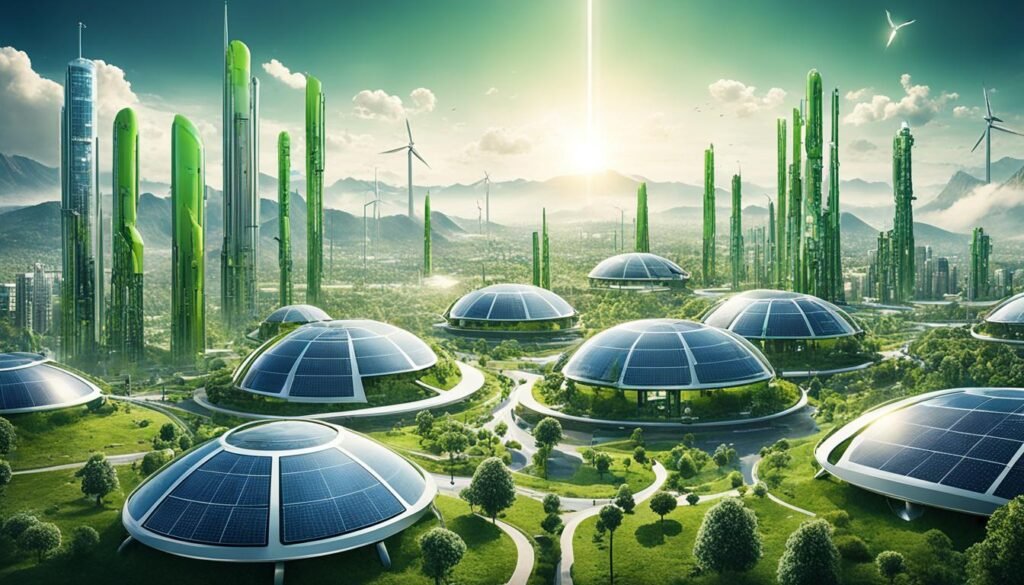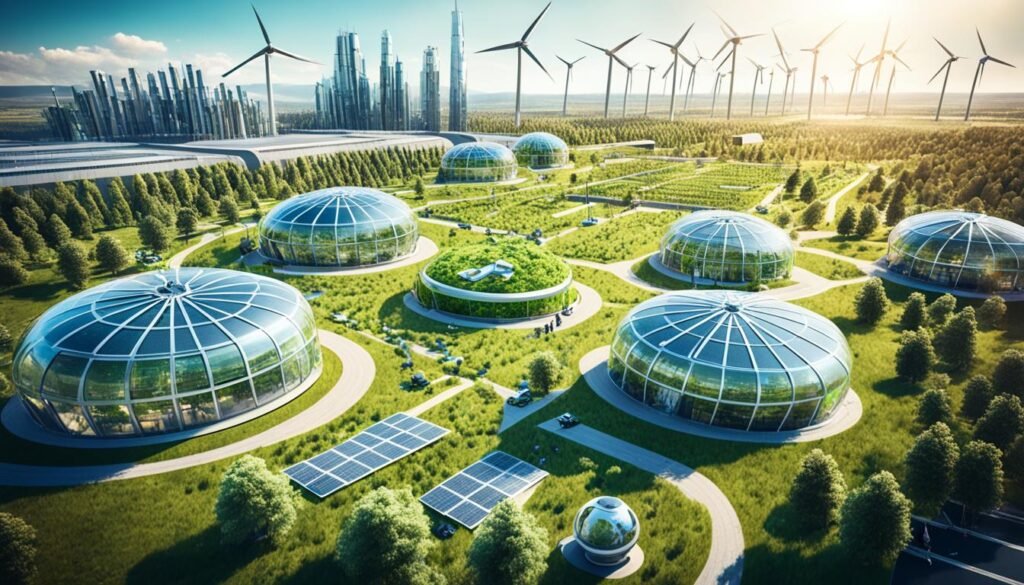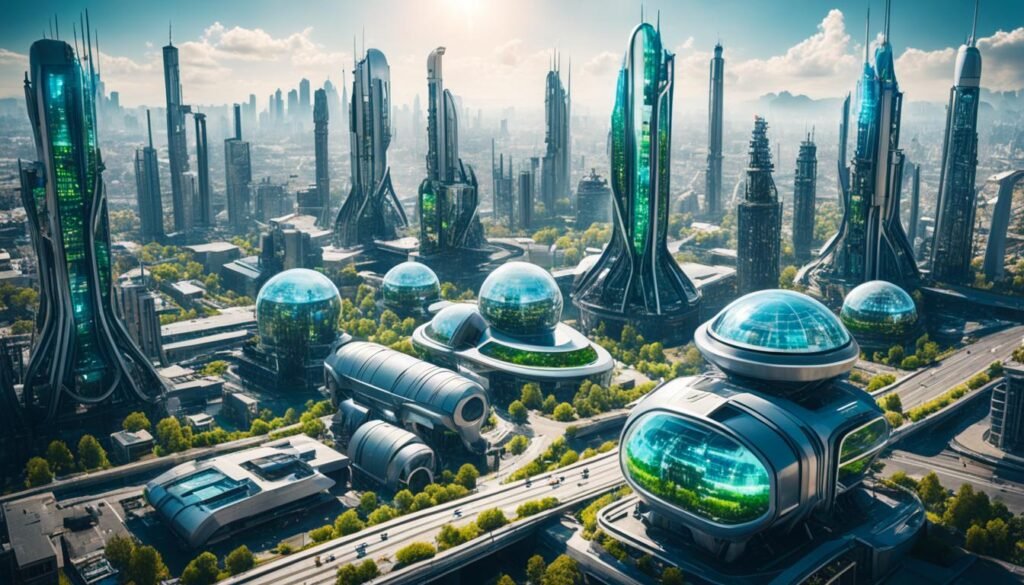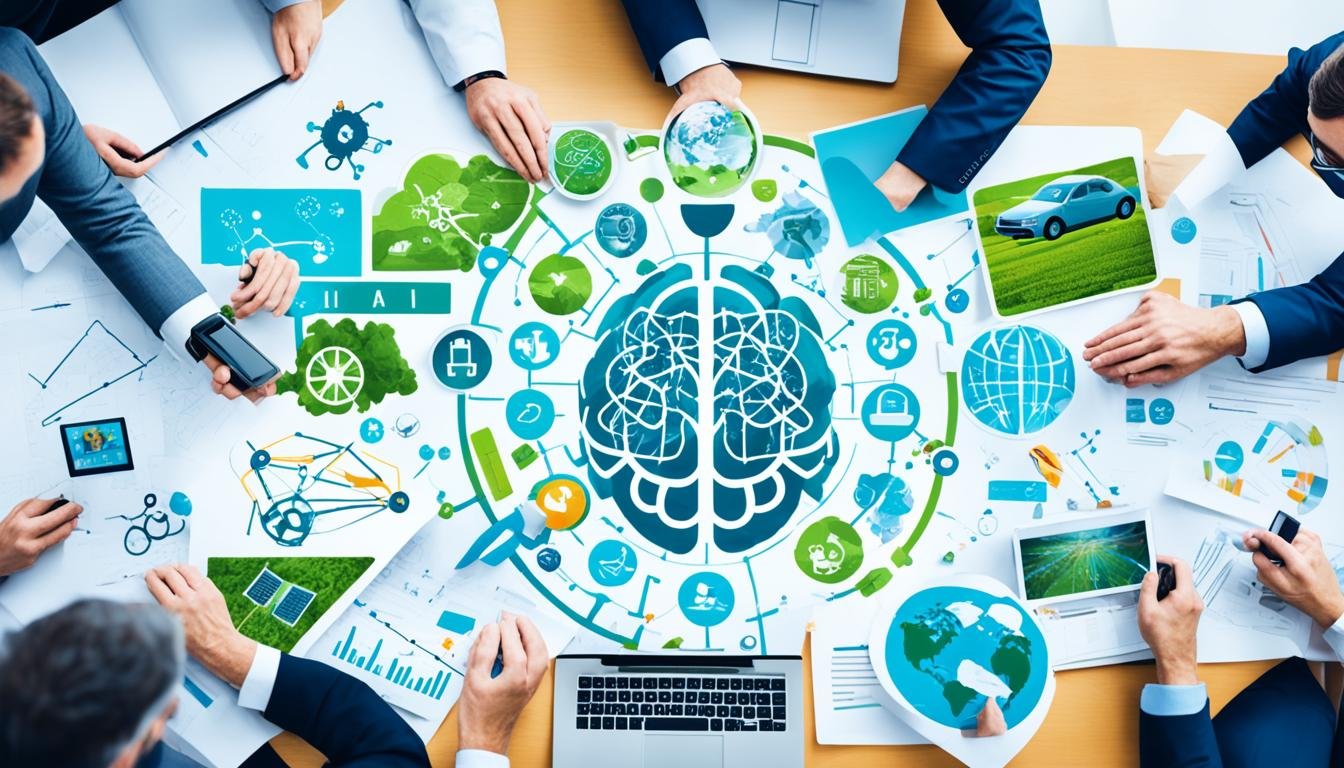Imagine a world where artificial intelligence (AI) is key to solving big global problems. It could change industries like healthcare and sustainability. Already, 89% of businesses are using or planning to use AI soon.
This article will show how AI can help with big issues. It can make medical diagnoses better and help in disasters. You’ll see how AI can make a big difference in people’s lives all over the world.
Key Takeaways
- Explore the transformative potential of AI in addressing global challenges
- Understand the diverse applications of AI across industries, from healthcare to sustainability
- Discover how AI can serve as a catalyst for positive change and social impact
- Gain insights into the ethical considerations and challenges associated with AI deployment
- Envision a future where AI-powered solutions can help solve the world’s most pressing problems
AI’s Transformative Potential in Global Challenges
Artificial intelligence (AI) is a powerful tool that can help solve many global problems. It’s being used in healthcare, saving the environment, and managing disasters. AI makes things more efficient and brings new solutions to the table.
Artificial Intelligence as a Catalyst for Change
Researchers use AI to tackle big societal and global issues. It helps scientists and engineers make new materials and drugs. AI speeds up data analysis, changing how we do research.
But, AI has its challenges like errors and biases in data, high energy use, and misuse risks. Scientists are working hard to make AI better and safe for everyone.
Diverse Applications Spanning Healthcare, Sustainability, and Disaster Management
AI is changing many areas. In healthcare, it can change how we diagnose and treat diseases, and even help make vaccines. For the environment, AI helps us tackle big issues like climate change and farming better.
In disaster management, AI helps with early warnings and making aid efforts better. AI looks at big data, finds patterns, and simulates complex situations. Working together, we can use AI to make things better.

“AI has the potential to revolutionize the way we approach and solve global challenges, from healthcare to sustainability and disaster management. The key is to harness this technology responsibly and collaboratively to create a better future for all.”
With AI, we can tackle the complex problems we face today. It offers hope for a better, more sustainable future for everyone.
Healthcare Innovations Through AI
AI is changing healthcare fast. It’s making disease diagnosis, drug discovery, and treatment better. This means patients will get care that fits their needs better.
Disease Diagnosis and Drug Discovery Advancements
AI uses big medical data to spot patterns and predict diseases. It can tell if someone has pneumonia from a CT scan with 90% accuracy. This helps doctors find and treat diseases faster.
AI is also changing how we find new drugs. Over 60% of recent studies talk about using AI in this area. It looks through huge amounts of data to find new drug possibilities quickly.
Personalized Medicine and Treatment Optimization
AI helps doctors make treatments that fit each patient better. This leads to better results and fewer side effects. For example, AI lets doctors work together safely without sharing patient data.
But, AI is still not widely used in healthcare. It’s important to make sure it’s used fairly and ethically. We need more research and teamwork to make sure AI helps everyone.

Environmental Conservation and Sustainability
AI is changing the way we tackle environmental issues, like climate change and saving nature. It’s helping us make renewable energy and use energy better in many areas.
Climate Change Mitigation and Renewable Energy Solutions
Big tech names like Google, Tesla, and Microsoft are using AI to make energy use better and cut down on carbon emissions. Google’s DeepMind uses AI to make cooling systems in data centers work better, saving energy and cutting down on emissions. Tesla uses AI in electric cars to make driving more efficient, which means less emissions.
GE Renewable Energy is using AI in wind turbines to make them work better. Sensors and algorithms predict wind conditions to make the turbines work at their best. AI is also helping make smart grids, which manage renewable energy sources better.
Biodiversity Monitoring and Precision Agriculture
AI is also helping with saving nature and making farming better. Companies like Farm Wise use AI robots to find and remove weeds in farms, cutting down on chemicals. Waste Robotics uses AI robots to sort recyclables from trash, making recycling better and reducing waste.
Conservation International uses advanced algorithms to track changes in ecosystems, helping make better conservation decisions. AI drones and cameras are also helping protect endangered animals, giving us insights for saving them.
| Application | AI-Powered Solution | Impact |
|---|---|---|
| Data Center Cooling | DeepMind’s AI optimization | Reduced energy consumption and carbon emissions |
| Electric Vehicle Efficiency | Tesla’s AI-driven autonomous driving features | Increased energy efficiency and reduced emissions |
| Wind Turbine Performance | GE Renewable Energy’s AI-powered sensors and algorithms | Enhanced renewable energy generation |
| Sustainable Agriculture | Farm Wise’s AI-powered weed identification and removal robots | Reduced reliance on chemical herbicides |
| Waste Recycling | Waste Robotics’ AI-powered sorting systems | Improved recycling efficiency and reduced landfill waste |
| Biodiversity Conservation | Conservation International’s advanced AI algorithms | Enhanced ecosystem monitoring and informed decision-making |
AI is making big changes in many areas to help the planet. It’s helping with everything from making renewable energy to protecting nature. AI is becoming a key tool for a greener future.

can ai solve world problems
The world faces many complex challenges, like climate change and healthcare gaps. Artificial Intelligence (AI) is stepping up to help solve these issues. With its advanced analysis, AI can tackle many societal problems and aim for a better future for everyone.
Empowering Healthcare and Disease Management
In healthcare, AI tools are showing great promise. They can accurately spot diseases like cancer, diabetes, and heart disease. This could change how we manage diseases, leading to earlier treatments and tailored care plans.
AI can also improve how we use resources and coordinate healthcare services. This means better and fairer access to medical care for all.
Sustainable Agriculture and Environmental Conservation
AI is also making a big difference in the environment. It helps farmers manage crops better, leading to more food with less resources. This helps fight climate change and ensures everyone has enough to eat.
AI can also help protect nature by monitoring and analyzing ecological data. This supports efforts to save endangered species and develop smart conservation plans.
Economic Development and Poverty Alleviation
AI is creating new jobs in fields like AI development and data science. This can boost the economy and help fight poverty by offering jobs and ways to make money. AI can also improve access to services for those who need them most.
As AI becomes more widespread, its ability to solve big problems is clear. It can change healthcare, protect the environment, and help the economy grow. By using AI, we can tackle global challenges with new and effective solutions.

“The integration of AI into various industries is anticipated to bring about unprecedented innovations and solutions to longstanding problems.”
Education and Personalized Learning
The future of education is changing fast, thanks to artificial intelligence (AI). AI technology is making learning more personal for students. Now, AI can check how well students are doing and change what they learn to fit their needs.
Studies show that soon, over 47% of learning systems will use AI. The AI in education market is growing fast, by 36% each year from 2022 to 2023. This change is helping students do better, with a 62% boost in test scores.
AI is changing how students learn, not just what they learn. AI chatbots and virtual tutors are helping students get help and feedback right away. These tools are great for students who can’t be in class or need extra help, showing 91% accuracy in helping students.
AI can also look at learning data to help make better decisions on teaching and curriculum. It can spot what students need emotionally and personally, making learning more complete and supportive.
| AI-Powered Learning Solutions | Key Benefits |
|---|---|
| Adaptive Learning Platforms | Tailored learning experiences, 62% increase in test scores |
| AI-Powered Chatbots and Virtual Tutors | Personalized guidance with 91% accuracy, support for remote and special needs students |
| AI-Powered Curriculum and Policy Enhancements | Informed decision-making, more efficient and equitable educational system |
As education changes, using AI in learning is very promising. AI can make learning more engaging, flexible, and welcoming for everyone. This way, students can achieve their best.
“AI technology has the potential to streamline educational institutions and enhance formal education, complementing the efforts of human teachers rather than replacing them.”
Disaster Response and Management Optimization
When natural disasters hit, AI is key in making response and management better. Machine learning looks at weather and earth data to predict disasters like hurricanes, earthquakes, and wildfires. This lets authorities give early warnings and act before it’s too late.
AI-Powered Early Warning Systems
AI early warning systems use data from IoT devices, weather stations, and satellites to spot disaster patterns. This means authorities can get ready and act fast, saving lives and buildings.
Humanitarian Aid Coordination and Distribution
AI drones and robots can go into dangerous areas to check damage and find survivors. Predictive analytics helps manage and improve how aid is given out. AI also helps with communication, planning, and getting back on our feet after disasters, making disaster response better.
| Application | AI Capabilities | Benefits |
|---|---|---|
| Early Warning Systems | Predictive modeling, real-time data analysis | Improved accuracy, timeliness, and preparedness |
| Damage Assessment | Drone and satellite imagery analysis, search and rescue | Faster response, better resource allocation |
| Humanitarian Aid Coordination | Predictive analytics, logistics optimization | Reduced response time, improved aid distribution |
Using ai in disaster management is changing how we get ready for, react to, and bounce back from disasters. It’s making communities stronger and more able to handle these tough times.
Urban Planning and Transportation Efficiency
Artificial Intelligence (AI) is changing urban planning and transportation. It brings new ways to make cities better, greener, and more livable. AI helps with everything from self-driving cars to smarter traffic lights.
Autonomous Vehicles and Traffic Management
Self-driving cars are becoming more common, thanks to AI. They can react quicker than humans in emergencies, making roads safer. AI also helps manage traffic by adjusting lights and finding the best routes, making travel smoother and cutting down on pollution.
Public Transportation Optimization
AI is making public transport better too. It looks at real-time data to plan bus and train routes better. This means people get where they need to go faster and more efficiently, making travel better for everyone.
But, using AI in cities comes with its own set of challenges. We need skilled workers, worry about keeping data safe, and making sure people trust these new technologies. Still, the benefits like better decisions and saving resources are clear. As cities aim to be smarter, AI will play a big part in making them work better.
| AI Application | Benefits |
|---|---|
| Autonomous Vehicles | Enhanced road safety, reduced congestion, and lower emissions |
| AI-Powered Traffic Management | Optimized traffic light synchronization, predictive analytics, and alternative route suggestions |
| Public Transportation Optimization | Improved user experience, reduced operational costs, and energy savings |
“AI is not just a tool in urban planning; it’s a catalyst for creating smarter, more livable cities that put people first.”
Poverty Alleviation and Economic Development
Artificial intelligence (AI) has a huge role in fighting global poverty and boosting economic growth. It uses advanced analytics and smart algorithms to find new solutions. These solutions help in areas like microfinance, job creation, and making the most of resources.
Microfinance and Job Creation Opportunities
AI helps by looking at who can get loans in poor areas. This makes getting loans easier for entrepreneurs. It also creates new jobs, like AI developers and data scientists, helping people find work and grow their income.
Resource Allocation Optimization
AI is great for helping governments and groups use their money well. It looks at data to find the best ways to fight poverty. This way, money goes where it can do the most good, making poverty-fighting efforts more effective.
| AI Application | Impact on Poverty Alleviation |
|---|---|
| Microfinance and Job Creation | Enhances financial inclusion, supports entrepreneurship, and creates new employment opportunities |
| Resource Allocation Optimization | Ensures efficient and effective channeling of resources to high-impact poverty reduction initiatives |
| Access to Electricity | Identifies optimal locations for renewable energy solutions, improving living standards and creating income-generating opportunities |
| Clean Water Provision | Detects water contamination sources and develops solutions, leading to improved health, hygiene, and sustainable living |
| Enhanced Agricultural Yields | Optimizes farming practices, resulting in increased crop yields and economic stability for farmers |
By using AI’s power, we can create a future where poverty is less and economies grow. This helps people and communities to do well.
Conclusion
Artificial Intelligence (AI) has huge potential to solve global problems. It can change healthcare, help the environment, improve disaster response, and boost economic growth. But, we must think carefully about the ethical sides and challenges of AI to use it right and fairly.
Hala Nelson, a top mathematician and AI expert, says AI can tackle big issues like climate change with new solutions. But, AI needs unbiased data to avoid unfairness. Working together, governments, groups, and the public can make the most of AI while reducing its risks.
The future of AI looks bright for solving problems. Companies are moving fast to use AI more, and many think it will become common soon. By tackling ethical issues and using AI wisely, we can make a better, fairer, and richer future for everyone.
FAQ
What are the diverse applications of AI in addressing global challenges?
AI is used in many areas like healthcare, saving the environment, education, managing disasters, planning cities, improving transport, and fighting poverty. It brings new solutions and big changes.
How is AI revolutionizing the healthcare sector?
AI is changing how we diagnose diseases, find new medicines, and treat patients. This leads to better health outcomes and fewer side effects.
What role does AI play in addressing environmental challenges?
AI helps make energy use sustainable, manage smart grids better, predict weather changes, track endangered animals, and improve farming.
How can AI tackle societal issues like poverty and economic development?
AI can better use resources, improve small loans and job chances, and make learning more personal to help students do better.
What is the impact of AI in disaster response and management?
AI can forecast disasters, check damage, manage aid, and make relief efforts more efficient. This makes disaster response better and more effective.
How is AI transforming urban planning and transportation?
AI makes travel safer, more efficient, and green by enabling self-driving cars, better public transport, and managing traffic in real-time.
What are the ethical considerations and challenges associated with the use of AI?
We must make sure AI is fair, unbiased, and used right to help everyone. This needs work from governments, groups, and the public together.
